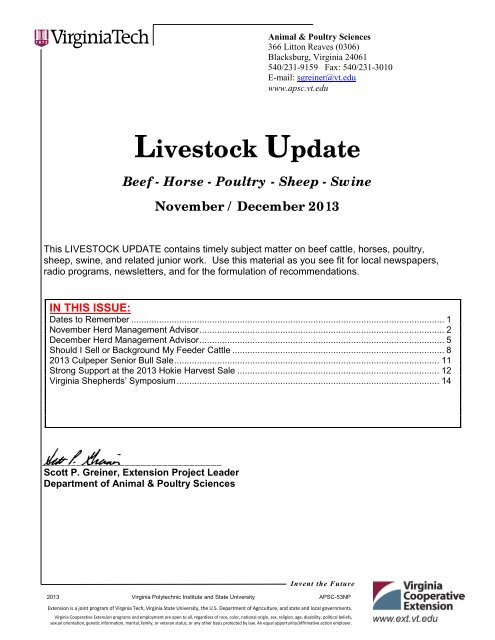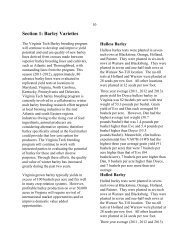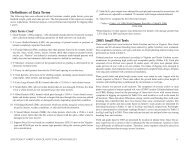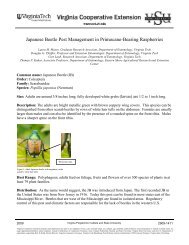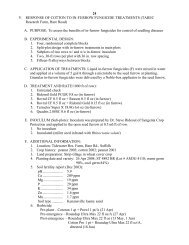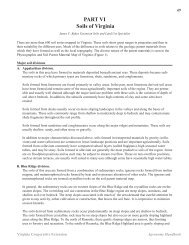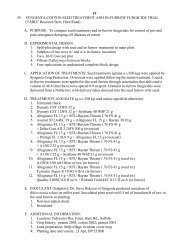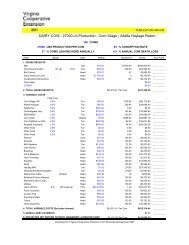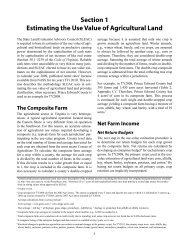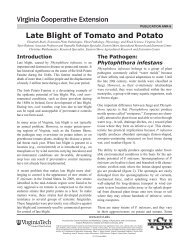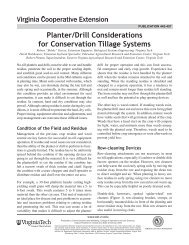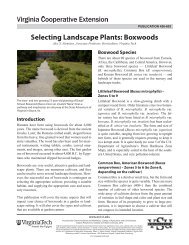PDF - Virginia Cooperative Extension - Virginia Tech
PDF - Virginia Cooperative Extension - Virginia Tech
PDF - Virginia Cooperative Extension - Virginia Tech
You also want an ePaper? Increase the reach of your titles
YUMPU automatically turns print PDFs into web optimized ePapers that Google loves.
Animal & Poultry Sciences<br />
366 Litton Reaves (0306)<br />
Blacksburg, <strong>Virginia</strong> 24061<br />
540/231-9159 Fax: 540/231-3010<br />
E-mail: sgreiner@vt.edu<br />
www.apsc.vt.edu<br />
Livestock Update<br />
Beef - Horse - Poultry - Sheep - Swine<br />
November / December 2013<br />
This LIVESTOCK UPDATE contains timely subject matter on beef cattle, horses, poultry,<br />
sheep, swine, and related junior work. Use this material as you see fit for local newspapers,<br />
radio programs, newsletters, and for the formulation of recommendations.<br />
IN THIS ISSUE:<br />
Dates to Remember ............................................................................................................................ 1<br />
November Herd Management Advisor ................................................................................................. 2<br />
December Herd Management Advisor ................................................................................................. 5<br />
Should I Sell or Background My Feeder Cattle .................................................................................... 8<br />
2013 Culpeper Senior Bull Sale ......................................................................................................... 11<br />
Strong Support at the 2013 Hokie Harvest Sale ................................................................................ 12<br />
<strong>Virginia</strong> Shepherds’ Symposium ........................................................................................................ 14<br />
_________________________________<br />
Scott P. Greiner, <strong>Extension</strong> Project Leader<br />
Department of Animal & Poultry Sciences<br />
Invent the Future<br />
2013 <strong>Virginia</strong> Polytechnic Institute and State University APSC-53NP<br />
<strong>Extension</strong> is a joint program of <strong>Virginia</strong> <strong>Tech</strong>, <strong>Virginia</strong> State University, the U.S. Department of Agriculture, and state and local governments.<br />
<strong>Virginia</strong> <strong>Cooperative</strong> <strong>Extension</strong> programs and employment are open to all, regardless of race, color, national origin, sex, religion, age, disability, political beliefs,<br />
sexual orientation, genetic information, marital, family, or veteran status, or any other basis protected by law. An equal opportunity/affirmative action employer.
Dates to Remember<br />
BEEF<br />
DECEMBER<br />
14 56 th Annual <strong>Virginia</strong> BCIA Culpeper Senior Bull Sale. 12:00 Noon. Culpeper Agricultural<br />
Enterprises. Culpeper. Contact: Scott Greiner, (540) 231-9159 or email:<br />
sgreiner@vt.edu<br />
SHEEP<br />
DECEMBER<br />
7 <strong>Virginia</strong> Sheep Producer’s Association Fall Bred Ewe & Doe Sale. 1:00 p.m.<br />
Rockingham County Fairgrounds. Harrisonburg. Contact: Scott Greiner,<br />
(540) 231-9159 or email: sgreiner@vt.edu<br />
JANUARY<br />
10-11 Sheep Management 101 Workshop and Shepherd’s Symposium. Alphin-Stuart<br />
Livestock Arena. Blacksburg. Contact: Scott Greiner, (540) 231-9159 or<br />
email: sgreiner@vt.edu<br />
1
November Herd Management Advisor<br />
Scott P. Greiner & Mark A. McCann<br />
<strong>Extension</strong> Beef Specialists, <strong>Virginia</strong> <strong>Tech</strong><br />
By November most areas have received their first frost and forage growth has slowed. Most<br />
spring-born calves have been weaned and marketed. Depending on accumulated forage<br />
inventory, hay feeding season is on the horizon. Economic analyses of cow-calf operations<br />
indicate that minimizing days of hay feeding is an important ingredient in profitability. Grazing<br />
crop residue and efficient utilization of stockpiled forages can delay hay feeding in many<br />
situations until after New Year’s. Most farms in the region found 2013 to be a challenge in<br />
regard to making quality hay. Forage testing is a valuable tool to assess the impact of harvest<br />
issues we faced this year. The most common problems were the amount of overly mature hay<br />
harvested, rain damaged hay and hay baled too wet. Visual estimation of hay nutrient content<br />
is always a guess but these additional issues make visual ranking of hay quality even more<br />
problematic. “Don’t guess, Forage test”.<br />
Spring Calving Herds (January-March)<br />
General<br />
• Implement marketing plan for calf crop, synchronize post-weaning grazing and feeding<br />
program as well as vaccination program with marketing plan. Calculate break-evens on<br />
various winter and spring marketing options and consider risk management strategies.<br />
• Schedule and conduct pregnancy diagnosis with veterinarian. Plan a marketing<br />
strategy for open cows which takes advantage of seasonality in cull cow price.<br />
• Finalize winter feed and forage supplies and options. Conduct forage tests to determine<br />
nutritional content of hays.<br />
Nutrition and Forages<br />
• Body Condition Score cows at weaning and separate thin cows<br />
• Use palatable feeds and high quality hay to background calves<br />
• Continue stockpiling tall fescue and begin strip grazing accumulated growth if needed<br />
• Continue to manage first-calf heifers separately; give them the best forage. Thin mature<br />
cows could be added to this group.<br />
• Continue to feed high Se trace mineral salt. A forage analysis can reveal what other<br />
minerals should be supplemented.<br />
• As warm season grasses go dormant, manage grazing to utilize dormant residue before<br />
too much weathering occurs.<br />
• Begin to shop and compare winter supplement options<br />
Herd Health<br />
• In consultation with your veterinarian, finalize vaccination and preconditioning protocol<br />
for calf crop.<br />
Reproduction<br />
• Conduct pregnancy check of cow herd with veterinarian<br />
• Cull open, old and thin cows and cows with problem udders, eyes and soundness<br />
issues<br />
2
Genetics<br />
• Collect weaning weights on calf crop at appropriate time (AHIR age range 120-280<br />
days), along with cow weights, hip heights and body condition scores (cow mature size<br />
data taken within 45 days of calf weaning measure).<br />
• Identify replacement heifers using objective measures including genetic background,<br />
dam performance, individual performance, along with phenotype. Keep only heifers<br />
born in defined calving season.<br />
Fall Calving Herds (September-November)<br />
General<br />
• Calving season is winding down for most. Continue to observe cows frequently.<br />
Address calving difficulties early.<br />
• Tag, tattoo, record birth weight, calving ease score, teat/udder score and mothering<br />
ability of dam. Keep accurate records at birth.<br />
• Monitor young calves for scours. Prevent scours by keeping calving area clean and<br />
well drained. Moving 2-3 day old pairs out of calving area to separate pasture (reduce<br />
commingling of newborn calves with older calves) help reduce exposure to scours.<br />
• Finalize winter feed and forage supplies and options. Conduct forage tests to determine<br />
nutritional content of hays.<br />
• Finalize plans and schedule for breeding season<br />
Nutrition and Forages<br />
• Evaluate growth of yearling heifers with goal of reaching 60-65% of mature weight by<br />
breeding. Depending on forage quality, supplementation may be needed to meet<br />
weight gain target.<br />
• Offer high magnesium mineral. Generally, fall calving cows are not as predisposed to<br />
grass tetany.<br />
• Reserve high quality hay and stockpiled pasture areas for cows post-calving. Use strip<br />
grazing as a tool to increase the efficiency of utilization of cool season pastures by cows<br />
post-calving.<br />
• If available, utilize crop aftermath<br />
• Use grazing management to utilize the residue of dormant warm season pastures.<br />
Herd Health<br />
• Ensure colostrum intake first few hours of life in newborn calves. Supplement if<br />
necessary. Newborn calves need 10% of body weight in colostrum first 24 hours of life.<br />
• Provide selenium and vitamin A & D injections to newborn calves<br />
• Castrate commercial calves at birth<br />
• Monitor calves closely for scours and pneumonia, have treatment supplies on hand.<br />
• Finalize and conduct pre-breeding vaccination schedule for cow herd and yearling<br />
heifers. Plan early to allow 30-day vaccination window prior to breeding season.<br />
Reproduction<br />
• Reproductive tract score and measure pelvic area on yearling replacement heifers.<br />
• Finalize plans and protocols for breeding season. Establish calendar to map timing of<br />
synchronization program to be used during breeding season. Confirm schedule with AI<br />
technician, have supplies and semen are on hand.<br />
3
• Breed heifers 2-4 weeks ahead of mature cows to allow longer post-partum interval<br />
prior to second breeding season.<br />
• Conduct breeding soundness exams on herd sires, including annual vaccinations. Do<br />
so prior to fall/early winter bull sales to allow time to secure replacements as necessary.<br />
• Breed heifers 2-4 weeks ahead of mature cows to allow longer post-partum interval<br />
prior to second breeding season.<br />
• Manage newly acquired herd sires properly to prepare them for the breeding season.<br />
Yearling bulls often lose 100+ pounds during their first breeding season. Adjust them to<br />
the feed and environment of their new home, and commingle bulls of same age/weight<br />
for a period of time prior to turnout. Ample exercise, in combination with a proper<br />
nutritional program, is essential to make them physically fit for the breeding season.<br />
Genetics<br />
• Collect yearling performance data (weight, height, scrotal, ultrasound) in seedstock<br />
herds.<br />
• Make plans for spring bull-buying season. Evaluate potential sources for bull purchase.<br />
Using herd genetic goals, establish benchmarks and selection criteria for bulls to be<br />
purchased. Secure new natural service sires in ample time to acclimate to your<br />
management and environment prior to breeding season.<br />
4
December Herd Management Advisor<br />
Scott P. Greiner & Mark A. McCann<br />
<strong>Extension</strong> Beef Specialists, <strong>Virginia</strong> <strong>Tech</strong><br />
The rapidly shortening days means that December is here. The shortest day or winter solstice<br />
will occur on December 21 st . Beyond the challenge of accomplishing cattle chores, short days<br />
bring an opportunity. As the year comes to a close, it is always an excellent time to reflect on<br />
the year you experienced with your cattle enterprise. As you review receipts and bills it<br />
important to keep the big picture in focus as you assess the details. The key to making<br />
significant changes is identifying the weaknesses in important areas which have a major<br />
impact on your bottom line and addressing the ones which will have the largest impact.<br />
Production and economic records are the necessary tools to begin the identification of the<br />
variables where the smallest change will have the greatest impact on your profitability. As you<br />
take advantage of the short days and work on your enterprise records, what pieces are you<br />
missing? The 2014 record year starts in less than a month.<br />
Spring Calving Herds (January-March)<br />
General<br />
• Begin preparation for calving season by checking inventory and securing necessary<br />
supplies (ob equipment, tube feeder, colostrum supplement, ear tags, animal health<br />
products, calving book, etc.)<br />
• Evaluate marketing options for calves not yet sold.<br />
• Evaluate cull cow marketing strategy, take advantage of seasonality in cull cow price.<br />
• Conduct forage tests to determine nutritional content of hays.<br />
Nutrition and Forages<br />
• Evaluate body score cows that you identified as thin and gauge if your management is<br />
making adequate progress.<br />
• Continue strip grazing accumulated fescue growth as needed.<br />
• Continue to manage first-calf heifers separately; give them the best forage. Thin mature<br />
cows could be added to this group.<br />
• Feed lower-quality hay to dry cows, saving the best hay for calving season<br />
• Continue to feed high Se trace mineral salt. A forage/hay analysis can reveal what<br />
other minerals should be supplemented.<br />
• Harvest impacts on feed costs have taken affect. Work to contract or lock-in winter feed<br />
needs at the most economical price.<br />
Herd Health<br />
• In consultation with your veterinarian, finalize vaccination and preconditioning protocol<br />
for calf crop.<br />
Reproduction<br />
• Cull open, old and thin cows and cows with problem udders, eyes and soundness<br />
issues.<br />
Genetics<br />
• Make plans for winter and spring bull-buying season. Evaluate potential sources for bull<br />
purchase. Using herd genetic goals, establish benchmarks and selection criteria for<br />
5
ulls to be purchased. Secure new natural service sires in ample time to acclimate to<br />
your management and environment prior to breeding season.<br />
• Identify replacement heifers using objective measures including genetic background,<br />
dam performance, and individual performance, along with phenotype. Keep only heifers<br />
born in defined calving season.<br />
Fall Calving Herds (September-November)<br />
General<br />
• Calving season is completed for most. Continue to observe late calving cows<br />
frequently.<br />
• Calving records should be complete and up to date.<br />
• Monitor calves for scours.<br />
• Begin breeding season.<br />
• Conduct forage tests to determine nutritional content of hays.<br />
• Initiate breeding season.<br />
Nutrition and Forages<br />
• As the breeding season begins, remember that maintaining or gaining weight have a<br />
major impact on pregnancy rate. As available forage becomes scarcer and of lower<br />
quality, be prepared to supplement as needed.<br />
• Offer high magnesium mineral. Generally, fall calving cows are not as predisposed to<br />
grass tetany. As cows transition from grazing to hay or silage, hi-mag minerals can be<br />
discontinued.<br />
• Use strip grazing as a tool to increase the efficiency of utilization of cool season<br />
pastures by cows post-calving.<br />
Herd Health<br />
• Consult with your veterinarian concerning pre-breeding vaccination schedule for cow<br />
herd, yearling heifers, and bulls. Plan early to allow 30-day vaccination window prior to<br />
breeding season.<br />
• Begin planning vaccination and preconditioning protocol to be used for calf crop at<br />
weaning<br />
• Castrate commercial calves if not done at birth, consider castrating bottom end of male<br />
calves in seedstock herds.<br />
• Monitor calf crop for health, have treatment options on hand.<br />
Reproduction<br />
• Reproductive tract score and measure pelvic area on yearling replacement heifers.<br />
• Implement plans and protocols for breeding season following pre-planned calendar and<br />
synchronization program. Confirm schedule with AI technician, have supplies and<br />
semen on hand. Take time to be precise with protocols for synchronization, estrus<br />
detection, and semen handling.<br />
• Breed heifers 2-4 weeks ahead of mature cows to allow longer post-partum interval<br />
prior to second breeding season<br />
• Use 48 hour calf removal for thin cows and first-calf heifers at beginning of breeding<br />
season<br />
• Schedule and conduct breeding soundness exams on herd sires, including annual<br />
vaccinations prior to turn-out.<br />
6
• Manage bulls properly during the breeding season. Observe frequently to confirm<br />
breeding activity and soundness, and monitor cows for repeat estrus. Avoid<br />
commingling mature and young bulls, as older bulls will be dominant. As rule of thumb,<br />
yearling bulls should be exposed to number of cows equal to their age in months (ie. 18<br />
month old bull with ~18 cows).<br />
Genetics<br />
• Finish collecting yearling performance data (weight, height, scrotal, ultrasound) in<br />
seedstock herds.<br />
7
Should I Sell or Background My Feeder Cattle<br />
Peter Callan (peter.callan@vt.edu), <strong>Extension</strong> Agent, Farm Business Management, Northern District and<br />
Kelly Liddington (klidding@vt.edu), <strong>Extension</strong> Agent, Animal Science, Richmond County<br />
The recent decline in corn prices has some <strong>Virginia</strong> cattle producers feeding 600 pound weaned calves<br />
to higher weights. Furthermore, this management decision has been supported by the strengthening of<br />
cattle prices in September with premiums on cattle futures in deferred months. Calculation of the cost<br />
of feed for an animal to gain one pound of weight is key to determining the profitability of retaining<br />
ownership of these cattle. This article discusses the profitability of keeping 600 pound feeder calves by<br />
feeding them simple and complex rations as compared to just taking the calves of the cows and selling<br />
at the sale barn.<br />
The <strong>Virginia</strong> Feeder Cattle Summary stated, that during September 2013 the weighted average price<br />
for a 6-7 weight medium and large #1 muscle feeder steers was~ $149/cwt. ($894/head gross value)<br />
and 8-9 weight steer in the same category was ~$137/cwt. ($1096 gross value). Jason Carter,<br />
Executive Secretary of the <strong>Virginia</strong> Cattlemen’s Association, indicated that preconditioned cattle which<br />
are vaccinated, weaned, bunk and water trough broken have historically added value to the cattle.<br />
Preconditioned programs have generated an average $8/cwt. premium and are preferred by buyers<br />
over animals that had not been preconditioned.<br />
Producers should note that the $8/cwt. premium is received only when the animals are sold in a<br />
preconditioned sale. The premium may increase even more when preconditioned animals are sold in<br />
trailer load lots (48,000 – 50,000 lbs.) and cattle originate from one farm or were co-mingled for more<br />
than 60 days.<br />
Feeder calves can be fed a variety of diets for backgrounding that range from 1) simple rations of<br />
commodity pellets and pasture or 2) complex and or complete ration (Table 1). In the first scenario, a<br />
producer feeds on average five pounds of a 14% protein pellet costing ~$.68/day based on September<br />
2013 prices for 167 days. Therefore during the fall and winter of 2013 – 2014, the remaining nutritional<br />
needs of the cattle are met from 2.5 acres of fall pastures[1] and stockpiled fescue. 1 Thus the animals<br />
will be ready for sale in the spring of 2014.<br />
A 725 lb. animal will eat ~22 lb. DM that is composed of 5 lb pellets (4.5 lb. DM) and 17.5 lb.[2] DM<br />
from pasture with an estimated rate of gain of 1.5 lb per day. 2 Each animal will require 2.5 acres of<br />
pasture at rental costs of $25/acre for an annual charge of $62.50. Adverse environmental conditions<br />
can reduce gain on pastures. Vaccinations and fly control/lice are estimated to be $15/head. The<br />
breakeven price for this type of backgrounding program is $131.91/cwt (Table 1) when feed costs,<br />
pasture rental, vaccinations, fly control/lice, hauling, marketing and interest on investment costs are<br />
included in the calculations.<br />
The second complex ration is composed of corn silage, barley silage, dry distillers grain, ground barley,<br />
48% soybean meal, wheat mids plus minerals will cost $1.63 per day based on September 2013 prices.<br />
This ration is estimated to produce an average daily gain of 2.5 lbs over the 100 days on feed. These<br />
animals will also receive vaccinations and fly control/lice at a cost of $15/head. The breakeven prices<br />
for feeding a more complex ration are $129.77/cwt (Table 1) when feed, vaccinations, fly control/lice,<br />
hauling, marketing and interest on investment costs are included in the calculations.<br />
Table 1 provides a side-by-side summary of the assumptions spelled out above and includes the base<br />
scenario of selling calves at weaning.<br />
8
Table 1: Assumption for analysis<br />
Assumptions<br />
Calves sold off the cow Calves fed simple Calves fed complex<br />
at sale barn<br />
ration (1)<br />
ration (2)<br />
Sale price $ / cwt. $149.00 $145.00 $145.00<br />
Sale weight 600 Lbs. 850 Lbs. 850 Lbs.<br />
Gross sale price $894.00 $1,233.00 $1,233.00<br />
Days on feed 167 days 100 days<br />
Averaged daily gain –<br />
1.5 2.5<br />
lb./day<br />
Purchased feed costs $111.47 $166.15<br />
Pasture costs (3) $62.50 0<br />
Vaccination & fly<br />
$15.00 $15.00<br />
control/lice<br />
Hauling costs. (4) $6.00 $8.00 $8.00<br />
Marketing costs (5) $21.38 $28.16 $28.16<br />
Subtotal costs $27.38 $225.13 $217.31<br />
Interest on investment (6) $29.96 $19.59<br />
Total cost to market $27.38 $255.09 $236.90<br />
Net value of calf $866.12 $866.12 $866.12<br />
Total costs $1121.21 $1103.02<br />
Net returns $866.12 $111.80 $129.98<br />
Breakeven costs / cwt (7) $131.91 $129.77<br />
(1) Average 5 lbs. 14% CP commodity pellets per day + pasture<br />
(2) Corn silage, barley silage, dry distillers grain, ground barley, soybean meal, wheat mids plus minerals<br />
(3) 2.5 acres/head (hd) at $25/acre<br />
(4) 600 lb animal/$6(hd), 850 lb animal/$8/(hd)<br />
(5) $3.50 hd + 2% gross sale price<br />
(6) 6% interest rate X (6 cwt. X 149/cwt calf marketing cost + subtotal costs) X (Days on Feed/365)<br />
(7) (total costs / 8.5 cwt).<br />
The market outlook for fat cattle will play an important role in determining whether a producer should<br />
sell calves that have not been weaned at the local sale barn or background them. In late September<br />
2013, the futures market offered a premium for fat cattle marketed in February and April 2014. The<br />
September 1, 2013 USDA Cattle on Feed report showed that the number of cattle in feedlots was down<br />
7 percent from 2012. Furthermore, the August placement of cattle in feedlots was 11 percent lower<br />
than one year ago. Therefore, it appears that the record feeder cattle prices will continue in the future.<br />
However, if demand for beef softens and/or the economy weakens; consumers will substitute lower<br />
priced chicken or pork for beef. Consequently, declining prices for fat cattle will cause feeder calf<br />
prices to decline.<br />
Every farm is different. By using their financial and production records, a producer should be able to<br />
estimate labor, fence repairs and equipment costs (loader tractor, mixer wagon, etc) and mortality rates<br />
that will be included in the calculation of breakeven costs to determine the profitability of retaining<br />
ownership of cattle. Clearly labor and equipment costs will be higher feeding a total mixed ration (TMR)<br />
than pasturing animals and feeding commodity pellets which will impact breakeven costs.<br />
Producers may reduce the risk of potential declines in feeder cattle prices by enrolling in the Livestock<br />
Risk Protection (LRP) Program. The LRP Program is a risk management tool that insures profits.<br />
When producers purchase LRP insurance, they are buying a policy that renders an indemnity<br />
(payment) if the Chicago Mercantile Feeder Cattle Cash Index falls below the insured coverage price.<br />
Coverage levels will depend on the amount of risk that the producer wishes to take. Remember, the<br />
longer the length of the policy, the risk of adverse price movements increases. Consequently,<br />
9
premiums will increase. It is recommended that producers work with their crop insurance agents to<br />
develop a LRP program that meets their net profit objectives.<br />
Management is the key to profitability. Producers that are able to optimize forage quality should be<br />
able to consistently have daily rates of gain 1.5 – 2.0 lb. / day using a preconditioning program feeding<br />
minimal levels of commodity pellets and good pasture. Likewise, producers that feed complex rations<br />
should be able to have daily rates of gain of 2.5+ lb. /day. Do not forget that weather conditions with<br />
excess heat, cold and precipitation can have a major impact on daily rates of gain and forage quality.<br />
With the potential for volatility in the grain markets during the fall of 2013, forward contracting<br />
purchased feed ingredients is an excellent way to lock in feed costs. Likewise, the LRP program is an<br />
excellent way for producers to lock in profits in the volatile cattle markets. On the other hand,<br />
producers that are unable to grow animals at the previously mentioned rates of gain would be better off<br />
selling the unweaned calves. Otherwise they may not generate a profit. Consequently, they will end up<br />
with cheap exercise for their hard work!<br />
[1] The pasture has moderate fertility, did not receive nitrogen to increase yields and produces 1,700<br />
pounds of dry matter (DM) per acre and has a rental rate of $25/acre. With 70% grazing efficiency,<br />
there are 1,190 lb. of DM available per acre of pasture. Dry matter intake will be three percent of body<br />
weight (BW). The DM intake is calculated as follows: 21.75 lb. (DM) = 725 lb. average weight (600 +<br />
850 lb. /2) X .03% (BW). The five pounds of 14% protein pelleted feed contains 4.5 lb DM = 5 lb. (90%<br />
DM).<br />
[2] Total pounds of DM from pasture are calculated as follows: 167 days X 17.5 lb. DM/day = 2922 lb.<br />
2922 lb. DM / 1190 lb. DM/acre = ~2.5 acres needed for pasture and stockpiled fescue.<br />
10
2013 Culpeper Senior Bull Sale<br />
Dr. Scott P. Greiner<br />
<strong>Extension</strong> Animal Scientist, <strong>Virginia</strong> <strong>Tech</strong><br />
The 56 th annual sale of the <strong>Virginia</strong> BCIA Culpeper Senior bulls will feature approximately 55<br />
fall-born yearling bulls on Saturday, December 14, 2013 at 12:00 noon at the Culpeper<br />
Agricultural Enterprises located on Route 29 just south of Culpeper, <strong>Virginia</strong>. These 55 fallborn<br />
bulls represent the top end of the 87 bulls developed. Currently, 50 Angus and 5<br />
Simmental Hybrid bulls are available for sale on December 14 th .<br />
The majority of the bulls selling are sired by trait-leading, highly proven AI bulls of each breed.<br />
All bulls selling meet minimum genetic requirements (EPDs) to sire calves for the VQA Purple<br />
Tag Feeder Calf Program. Bulls have been screened for reproductive and structural<br />
soundness and sell with the BCIA enhanced guarantee for soundness and fertility. Complete<br />
performance information will be available on all bulls, including growth, maternal, and carcass<br />
EPDs, detailed test performance information, and ultrasound data.<br />
Again this year, we will feature video clips of each of the bulls available for sale. These video<br />
clips provide buyers a good opportunity to preview the bulls prior to sale day and can be found<br />
on the BCIA website http://www.bcia.apsc.vt.edu .<br />
In addition to the bulls, BCIA will feature a select group of 32 bred heifers immediately<br />
following the bulls. Glenmary Farm is proud to offer a high quality set of commercial bred<br />
heifers. As the 2012 <strong>Virginia</strong> Commercial Producer of the Year, Glenmary Farms prescribes to<br />
the performance and genetic principles of BCIA. All heifers are certified as <strong>Virginia</strong> Premium<br />
Assured Heifers.<br />
<strong>Virginia</strong> BCIA would like to thank Southern States and Mike Shanahan of Shanahan Cattle<br />
Promotions for their support of the video feature.<br />
For video clips as well as catalogs and detailed information on the bulls and heifers visit the<br />
website http://www.bcia.apsc.vt.edu, or phone <strong>Virginia</strong> BCIA at 540-231-9159 or Glenmary<br />
Farm at 540-672-7396.<br />
11
Strong Support at the 2013 Hokie Harvest Sale<br />
Dr. Dan Eversole<br />
Animal and Poultry Sciences, <strong>Virginia</strong> <strong>Tech</strong><br />
The 2013 Livestock Merchandising Class at <strong>Virginia</strong> <strong>Tech</strong> entertained a standing-room-only<br />
crowd of over 500 supporters, alumni, and friends in the Livestock Judging Pavilion at the 19 th<br />
Annual Hokie Harvest Sale on Friday, October 25 th . As many of you know, the Hokie Harvest<br />
Sale has developed a significant reputation for selling high quality, university-owned livestock.<br />
Since 1995, which was the inaugural year of the Hokie Harvest Sale, there have been 1354<br />
students enrolled in this merchandising class and a grand total of 362 horses, 46 pigs, and 833<br />
head of beef cattle have been offered at public auction, totaling $2,145,693 in gross revenue.<br />
This year’s sale grossed $120,200 and featured 48 lots of purebred and commercial beef cattle<br />
that were offered to 153 registered buyers from Ohio, Illinois, Tennessee, Florida, North<br />
Carolina, West <strong>Virginia</strong>, South Carolina, and <strong>Virginia</strong>. Mr. Aaron Ray Tompkins, Cowbuyer<br />
LLC of Mt. Airy, NC broadcasted the entire sale live over the internet. Mr. Chris Terembes,<br />
Executive Sires, Inc. of Charlottesville, VA stopped by and interviewed Dr. Dan Eversole and<br />
several of his students for live sale day coverage on LivestockWorld.TV. The beef cattle sale<br />
featured 29 head of commercial bred females and 29 cattle representing three different<br />
purebred breeds – Angus, Hereford, and Simmental.<br />
There were 7 spring-calving pairs in the cow/calf division, which averaged $4,388. Lot 2 was<br />
the sale topper at $4,900. This four-year-old Angus cow is a daughter of GAR New Design<br />
5050 and is a natural calf of the $10,000 valued VT donor, HHF Alli Rita 704 317. She ranks<br />
in the top 10% among current dams for CED, MARB, and $B at $81.83 as well as the top 4%<br />
on her Milk EPD. Both she and her phenomenal February heifer calf sired by SS Incentive<br />
9J17 sold to Dave Beachy of New Matamoras, OH.<br />
In the Hereford cow/calf division, Lot 8 commanded the highest bid at $2,700. This three-yearold<br />
female, sired by KCF Bennett 774 R413, ranks in the upper 5% for BMI$, top 10% for<br />
CEZ$, and top 15% on her MILK and M&G EPDs. She and her August baby heifer calf, sired<br />
by UPS Domino 3027, sold to Matthew Taylor of Sandyville, WV.<br />
Lot 10 was the top-selling lot in the Simmental breed. Estes Farm from Eden, NC purchased<br />
the purebred cow by SAS T101 Sweet Meat at $2,800 and her homozygous black January bull<br />
calf sired by Dikemans Sure Bet sold to Jessie Williams of Pembroke, VA for $1,800. Her herd<br />
sire prospect ranks in the elite 2% on his MARB EPD and the top 10% on API and TI.<br />
The breeding-age bull division of 8 yearling bulls was topped by Lot 13 at $3,500. This Angus<br />
yearling bull is sired by GAR Prophet and out of a daughter of GAR Predestined and our<br />
featured donor cow, HHF Alli Rita 704 317. He blended a flawless phenotype with muscle and<br />
volume and will certainly add pounds, growth, and pedigree value to any cow/calf operation.<br />
This popular herd-sire prospect ranks in the elite 1% of non-parent sires for $QG and MARB,<br />
the top 2% on WW EPD, and upper 3% on $B, $F, and YW EPD. Arvid Mykleburst of New<br />
Castle, VA is the new owner.<br />
The 29 head of commercial bred heifers and cows, mostly Angus or SimAngus breeding, drew<br />
considerable interest among cattlemen and averaged $1,990. Bidding was lively and<br />
numerous buyers swept the ring on female groupings. Glen Shipway of Kiawah Island, SC<br />
and Carl Crookshanks of Covington, VA were the volume buyers on these productive bred<br />
females.<br />
12
This was the largest class of merchandising students in the 19-year history of the Hokie<br />
Harvest Sale. The 103 students which comprised nine committees did a superb job of<br />
preparing for the sale and all gained ‘hands-on’ experience in sale management, budgeting,<br />
cataloging, advertising, livestock photography, clerking, and health requirements. Special<br />
thanks are extended to Col. Ken Brubaker of Brubaker Sales and Marketing, Harrisonburg, VA<br />
for guest lecturing and serving as the sale consultant and auctioneer. In addition to Aaron Ray<br />
Tompkins and Chris Terembes, a huge ‘thank you’ is extended to our guest speakers Tom<br />
Burke, American Angus Hall of Fame, Smithville, MO, Julie and Martin Macqueen, High Road<br />
Livestock Photography of Covington, VA, and Dr. Terry Swecker of the VT College of<br />
Veterinary Medicine for sharing their expertise and time to support this year’s class and Hokie<br />
Harvest Sale. Students Kurtis Devore, Mulberry Grove, IL; Abby Houchin, Raleigh, NC; and<br />
Stiles Milton, Shawsville, VA served as bid-takers for the sale while Keagan Clevenger,<br />
Stephenson, VA and Mason Thomas, Madison Heights, VA worked the ring. Logan Miller,<br />
Glen Allen, VA served as the student clerk in the block.<br />
The Food and Beverage Committee, with assistance from the Block and Bridle Club in the<br />
Department of Animal and Poultry Sciences, served a complimentary BBQ dinner to nearly<br />
550 guests. Their support and cooperation are greatly appreciated.<br />
Interest in the Hokie Harvest Sale continues to be overwhelming in favor of hosting future<br />
student-run livestock sales. However, as many of you know who host annual production sales,<br />
purebred and commercial animal inventory numbers need to remain strong to continually offer<br />
quality livestock at public auction. We are hopeful to host the 20 th Annual Hokie Harvest Sale<br />
on Friday, October 31, 2014. Mark your calendars now and we hope that you can ‘Come and<br />
Experience the Harvest’!<br />
Ringman Stiles Milton from Shawsville, VA taking bids on the<br />
high selling lot.<br />
Pre-sale comments by Dr. Dan Eversole and<br />
Mr. Ken Brubaker (auctioneer) along with Logan<br />
Miller from Glen Allen, VA (student clerk) and<br />
Mason Thomas from Madison Heights (in sale ring)<br />
13
<strong>Virginia</strong> Shepherds’ Symposium<br />
January 10-11, 2014<br />
Alphin-Stuart Livestock Arena, <strong>Virginia</strong> <strong>Tech</strong>, Blacksburg, VA<br />
Dr. Scott P. Greiner<br />
<strong>Extension</strong> Animal Scientist, <strong>Virginia</strong> <strong>Tech</strong><br />
Program Overview:<br />
Friday, January 10<br />
9:00 am- Sheep Management 101 Workshop<br />
5:00 pm All day workshop for beginning shepherds covering topics related to basic sheep production and<br />
lambing management. Workshop will include hands-on activities with sheep.<br />
(*additional registration fee, limited to first 20 participants registered)<br />
4:00 pm <strong>Virginia</strong> Sheep Industry Board Meeting (open to public)<br />
Alphin-Stuart Livestock Arena<br />
6:00 <strong>Virginia</strong> Sheep Producers Association Board Meeting (open to public)<br />
Alphin-Stuart Livestock Arena<br />
Saturday, January 11- all activities at Alphin-Stuart Livestock Arena<br />
8:15 am Registration & Commercial Exhibits<br />
9:00 “Key Components to Successful Flock Health”<br />
Dr. Hollie Schramm, DVM, <strong>Virginia</strong>-Maryland Regional College of Veterinary Medicine<br />
9:45 “Lamb Market Situation and Outlook”<br />
Dr. David Anderson, Texas A&M University<br />
10:45 “The Hale Report- American Lamb Industry Roadmap Project”<br />
Mr. Bob Leer, ASI Executive Board- Region II Director, Indiana<br />
“American Lamb Board & Your Checkoff Dollars”<br />
Mr. Leo Tammi, Director- American Lamb Board, Mt. Sidney, VA<br />
11:45 Roy Meek Outstanding Sheep Producer Award Presentation<br />
<strong>Virginia</strong> Sheep Producers Association Annual Business Meeting<br />
12:15 pm Lamb Lunch<br />
1:00 pm “Coping With Predators: What have we learned?”<br />
Mr. Chad Fox, USDA-APHIS, Christiansburg, VA<br />
1:45 “Minerals and Vitamins for the Flock”<br />
Dr. Mark McCann, Department of Animal & Poultry Sciences, <strong>Virginia</strong> <strong>Tech</strong><br />
2:30 “Progress Reports on Sheep Research at <strong>Virginia</strong> <strong>Tech</strong>”<br />
Dr. Scott Greiner, Department of Animal & Poultry Sciences, <strong>Virginia</strong> <strong>Tech</strong><br />
Dr. Mark McCann, Department of Animal & Poultry Sciences, <strong>Virginia</strong> <strong>Tech</strong><br />
Mr. Lee Wright, Southwest AREC, <strong>Virginia</strong> <strong>Tech</strong><br />
Dr. Anne Zajac, DVM, <strong>Virginia</strong>-Maryland Regional College of Veterinary Medicine<br />
3:30 “Producer Panel: Capturing Marketing Opportunities to Add Value”<br />
Early Registration Deadline: January 5, 2014 (registrations also taken on-site day of program)<br />
For registration information visit http://www.vtsheep.apsc.vt.edu or contact Dr. Scott Greiner, Department<br />
of Animal & Poultry Sciences, <strong>Virginia</strong> <strong>Tech</strong>, phone (540) 231-9159, email sgreiner@vt.edu<br />
14


